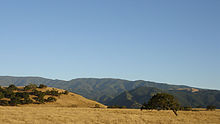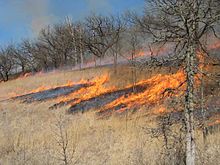- Oak savanna
-
An oak savanna is a type of savanna, or lightly forested grassland, where oaks (Quercus spp.) are the dominant tree species. These savannas were maintained historically through wildfires set by lightning, grazing, low precipitation, poor soil, and/or fires set by Native Americans. Although there are pockets of oak savanna almost anywhere in North America where oaks are present, there are three major oak savanna areas: 1) California and Oregon in the west; 2) Southwestern United States and Mexico; and 3) the prairie/forest border of the Midwest.[1][2]
Contents
California oak savannas
Main article: California oak woodlandSee also: Grasslands of CaliforniaThe oak savannas of California were dominated by, though not exclusively composed of, Valley oak in the coastal regions' interior valleys and hills of the California chaparral and woodlands ecoregion, and in the San Joaquin Valley and Sacramento Valley of the Central Valley ecoregion and terrestrial biome.
Oregon oak savanna
Main article: Willamette Valley forestsQuercus garryana and Quercus kelloggii form oak savanna in the Pacific Northwest.
- Oak savanna is found in several areas in the Klamath Mountains ecoregion.
- A small section of Oregon White Oak savanna is preserved at Mount Pisgah Arboretum in Eugene, Oregon.
Edwards Plateau savanna
Main article: Edwards Plateau savannaThe Edwards Plateau of central Texas is distinguished by juniper-oak savannas, underlain by medium and short grasslands.
Midwestern oak savannas
Main articles: Upper Midwest forest-savanna transition and Central forest-grasslands transitionThe oak savannas of the Midwestern United States form a transition zone between the Great Plains to the west and the broadleaf and mixed forests to the east, which were the eastern savannas prior to European settlement. Oak savannas are found in a wide belt from northern Minnesota and Wisconsin, down through Iowa, Illinois, northern and central Missouri, eastern Kansas, and central Oklahoma to north-central Texas, with isolated pockets further east around the Great Lakes.[3] The World Wildlife Fund divides the oak savannas into two ecoregions, the Upper Midwest forest-savanna transition and the Central forest-grasslands transition, distinguished by the predominant tree species. The bur oak (Quercus macrocarpa) is the dominant species in the north, while the dominant tree in the south is usually the black oak (Quercus velutina), although the chinquapin oak (Quercus muhlenbergii) is also common. The dominant grass species is typically the little bluestem (Schizachyrium scoparium). Oak savannas, because of their mixture of grassland and oak forest, typically are inhabited by more species of plant and animal than grasslands, temperate forests, and sometimes understory jungles, combined.[citation needed] The top predator in modern-day Midwest oak savannas is the coyote. The most prevalent herbivore is typically the gray, brown, or gray-brown squirrel, and/or the white tail deer.
History
Before European settlement, the oak savanna ecosystem was part of a fire ecology. Fires, set by lightning or Native Americans, ensured that the savanna areas did not turn into forests. Only trees with a high tolerance for fire, principally certain oak species, were able to survive. On sandy soils, black oak (Quercus velutina) predominated. On rich soils bur oak (Quercus macrocarpa) was the major tree in central North America. These savanna areas provided habitat for a many grazing animals, including American bison, elk and white-tailed deer.
European settlers cleared much of the savanna for agricultural use. In addition, they suppressed the fire cycle. Thus surviving pockets of savanna typically became less like savannas and more like forests or thickets. Many oak savanna plant and animal species became extinct or rare.
Restoration
In the 1970s, conservation began in the ecological restoration and land-habitat preservation of the surviving areas and regions of oak savanna. This includes grazing timing, restoration replanting, controlled burns, and basic land acquisitions and conservation easements for nature preserves to protect their space needs.
Current distribution
Surviving pockets of oak savanna can be found throughout the historical range of this ecosystem. Many are protected and maintained by government bodies or non-profit organizations such as The Nature Conservancy and the Iowa Natural Heritage Foundation. Examples include the Neal Smith Wildlife Refuge in Prairie City, Iowa, the Indiana Dunes National Lakeshore in Indiana, the Oak Openings Preserve Metropark in Ohio, and, in Ontario, Pinery Provincial Park on Lake Huron, and the Chicago Wildlife Fund. An excellent example of a restored oak savanna is Wisconsin's Pleasant Valley Conservancy State Natural Area.
References
- ^ McPherson, Guy R. 1997. Ecology and Management of North American Savannas. University of Arizona Press, Tucson.
- ^ Anderson, Roger A., Fralish, James S. and Baskin, Jerry M. editors.1999. Savannas, Barrens, and Rock Outcrop Plant Communities of North America. Cambridge University Press.
- ^ Nuzzo, V.A. 1986. Extent and status of Midwest oak savanna: presettlement and 1985. Natural Areas Journal 6: 6-36.
External links
- Upper Midwest forest-savanna transition (World Wildlife Fund)
- Central forest-grasslands transition (World Wildlife Fund)
- Oak Savannas: Characteristics, Restoration, and Long-Term Management
- Pleasant Valley Conservancy State Natural Area (Wisconsin)
Categories:- Ecoregions
- Grasslands
- Quercus
- Plant communities of California
- California chaparral and woodlands
- Nearctic
Wikimedia Foundation. 2010.




